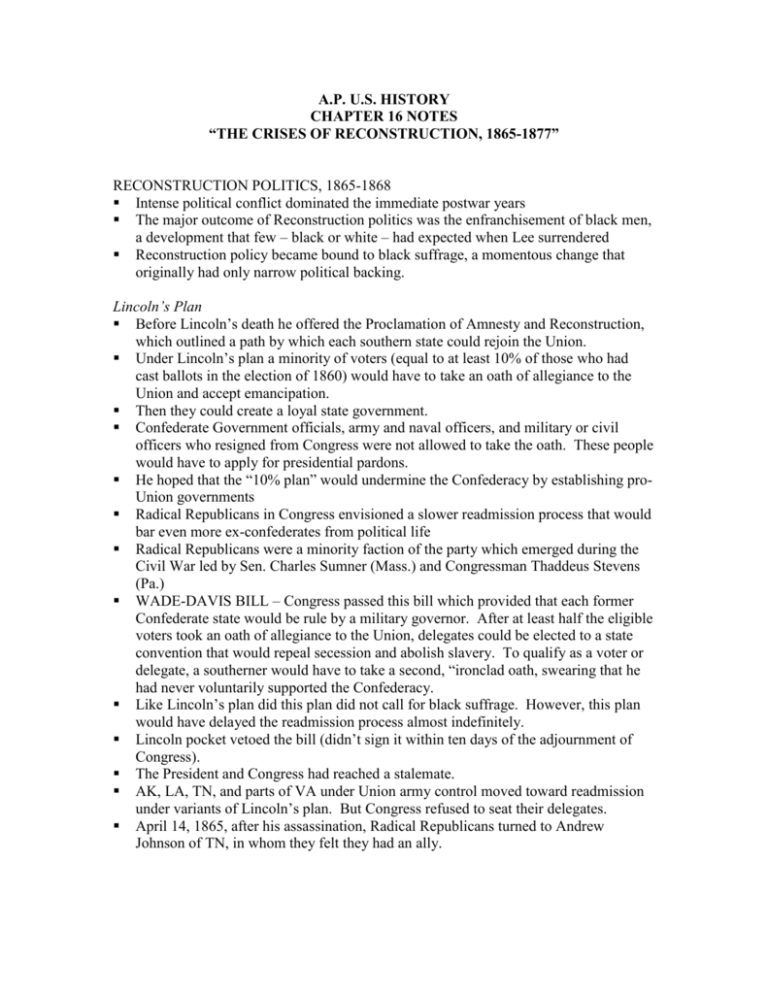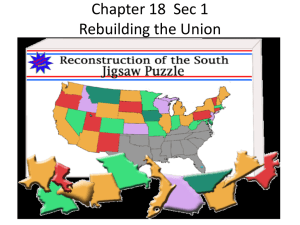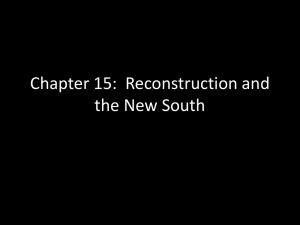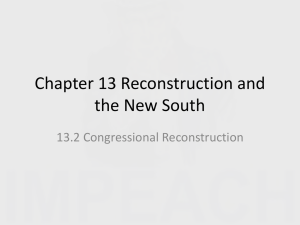Republicans in Retreat - Waterford Union High School
advertisement

A.P. U.S. HISTORY CHAPTER 16 NOTES “THE CRISES OF RECONSTRUCTION, 1865-1877” RECONSTRUCTION POLITICS, 1865-1868 Intense political conflict dominated the immediate postwar years The major outcome of Reconstruction politics was the enfranchisement of black men, a development that few – black or white – had expected when Lee surrendered Reconstruction policy became bound to black suffrage, a momentous change that originally had only narrow political backing. Lincoln’s Plan Before Lincoln’s death he offered the Proclamation of Amnesty and Reconstruction, which outlined a path by which each southern state could rejoin the Union. Under Lincoln’s plan a minority of voters (equal to at least 10% of those who had cast ballots in the election of 1860) would have to take an oath of allegiance to the Union and accept emancipation. Then they could create a loyal state government. Confederate Government officials, army and naval officers, and military or civil officers who resigned from Congress were not allowed to take the oath. These people would have to apply for presidential pardons. He hoped that the “10% plan” would undermine the Confederacy by establishing proUnion governments Radical Republicans in Congress envisioned a slower readmission process that would bar even more ex-confederates from political life Radical Republicans were a minority faction of the party which emerged during the Civil War led by Sen. Charles Sumner (Mass.) and Congressman Thaddeus Stevens (Pa.) WADE-DAVIS BILL – Congress passed this bill which provided that each former Confederate state would be rule by a military governor. After at least half the eligible voters took an oath of allegiance to the Union, delegates could be elected to a state convention that would repeal secession and abolish slavery. To qualify as a voter or delegate, a southerner would have to take a second, “ironclad oath, swearing that he had never voluntarily supported the Confederacy. Like Lincoln’s plan did this plan did not call for black suffrage. However, this plan would have delayed the readmission process almost indefinitely. Lincoln pocket vetoed the bill (didn’t sign it within ten days of the adjournment of Congress). The President and Congress had reached a stalemate. AK, LA, TN, and parts of VA under Union army control moved toward readmission under variants of Lincoln’s plan. But Congress refused to seat their delegates. April 14, 1865, after his assassination, Radical Republicans turned to Andrew Johnson of TN, in whom they felt they had an ally. Presidential Reconstruction Under Johnson He was the only southern senator to remain in Congress when his state seceded. He said that treason is a crime. He also wanted to get rid of the planter aristocracy in the South. He used to own slaves, but changed his position during the war, when emancipation became Union policy he supported it. He wanted it gone more to punish the rich rather than giving blacks rights. May 1865 – Johnson’s new plan: Congress was out of session and not due to convene until Dec. In two proclamations, he laid out how 7 southern states without reconstruction governments could return to the Union. o All southerners who took an oath of allegiance would receive a pardon and amnesty, and all their property except slaves would be restored. Oath takers could elect delegates to state conventions, which would provide for regular elections. Each state convention, Johnson later added, would have to proclaim the illegality of secession, repudiate state debts incurred when the state belonged to the Confederacy, and ratify the 13th amendment, which abolished slavery. o As under Lincoln’s plan, Confederate civil and military officers could not take the oath needed to vote. He also disqualified all well-off ex-Confederates – those with taxable property worth $20,000 or more. Presidential Reconstr4uction took effect in the summer of 1865, with unforeseen consequences. Southerners who were disqualified appealed for pardons and Johnson gave them out in droves, 13,000 of them. He also dropped plans for the punishment of treason. By the end of 1865, all 7 states had created new civil governments that in effect restored the status quo from before the war. They passed “black codes” to replace the slave codes. Because of the 13th amendment all states guaranteed the freedmen some basic rights like owning property, marry, make contracts, and testify in courts against other blacks. But they severely restricted their behavior. Black Codes: (1) prohibited blacks from buying or selling land, (2) set up segregation in public places, (3) effectively barred former slaves from leaving the plantations, (4) prohibited intermarriage, (5) barred blacks from serving on juries or giving court testimony against whites. When Congress convened in December 1865, it refused to seat the delegates of the ex-Confederate states. Establishing the Joint (House-Senate) Committee on Reconstruction – they wanted to get rid of black codes and lock ex-Confederates out of power. Congress Versus Johnson The political parties were divided on the issue of suffrage. Johnson alienated a majority of moderates and pushed them into the Radicals’ arms. The moderate Republicans supported two proposals to get rid of the black codes. These measures won wide Republican support. o (1) Congress voted to continue the Freedmen’s Bureau, established in 1865, whose term was ending. They provided relief, rations, and medical care. It also built schools for freed blacks, put them to work on abandoned or confiscated lands, and tried to protect their rights as laborers. It extended its life for three years and allowed it to run special military courts to settle labor disputes and could invalidate labor contracts forced on freedmen by the black codes. Johnson vetoed this bill. The Constitution, he declared, did not sanction military trials of civilians during peacetime. o (2) In March 1866 they passed a second measure, a bill that made blacks US citizens with the same civil rights as other citizens and authorized federal intervention in the states to ensure black rights in court. Johnson vetoed this as well. He said it would work for the colored instead of the white race. In April, Congress overrode his veto. The CIVIL RIGHTS ACT of 1866 was the first major law ever passed over a presidential veto. They also enacted the Freedmen’s act as well over his veto. He did not support them because the South wasn’t present – so he gained support in the south and that of Northern Democrats. Johnson’s vetoes (though both overridden by Congress) angered moderate Republicans and united them with the Radical Republicans 1866 midterm elections Republicans gained enough seats to override vetoes Once united, the Republicans moved on to a third step: the passage of a constitutional amendment that would prevent the Supreme Court from invalidating the new Civil Rights Act and would block Democrats in Congress from repealing it. The Fourteenth Amendment, 1866 Its first clause said that all persons born or naturalized in the US were citizens of the nation and citizens of their states and that no state could abridge their rights without due process of law or denies them equal protection of the law. This nullified Dred Scott Second, the amendment guaranteed that if a state denied suffrage to any of its male citizens, its representation in Congress would be proportionally reduced. Third, the amendment disqualified from state and national office ALL prewar officeholders – civil and military, state and federal – who had supported the Confederacy, unless Congress removed their disqualifications by a 2/3 vote. They wanted to invalidate Johnson’s pardons. Finally, the amendment repudiated the Confederate debate and maintained the validity of the federal debt They recognized that southern states would not deal fairly with blacks unless forced to do so. Southern legislatures, except TN, refused to ratify the amendment and Johnson denounced it. (in July 1868 it was ratified after Congress made ratification a prerequisite for readmission of Confederate states) Congressional Reconstruction, 1866-1867 RECONSTRUCTION ACT OF 1867 – Johnson vetoed it – Congress overrode his veto – Later that year and in 1868, Congress passed three more Reconstruction acts, all enacted over presidential vetoes. This act invalidated the state governments formed under Lincoln and Johnson’s plans. Only TN escaped further Reconstruction because they had ratified the 14th amendment. This Act divided the 10 Confederate states into 5 military zones, each run by a Union general. Voters who were eligible cold elect delegates to a state convention that would write a new state constitution granting black suffrage. When eligible voters ratified the new constitution, elections could be held for state officers. Once Congress approved the state constitution, and the state government ratified the 14th amendment, and once it became part of the federal constitution, Congress would readmit the state into the Union – and Reconstruction, in a constitutional sense would be complete. It provided for only temporary military rule, it did not prosecute Confederate leaders for treason or permanently exclude them from politics, and it made no provision for the confiscation or redistribution of property. Congressional Reconstruction took effect in the spring of 1867, but it could not be enforced without military power. Johnson impeded the congressional plan by replacing military officers sympathetic to the Radical cause with conservative ones. Moderates again joined forces to block Johnson from obstructing Reconstruction. The Impeachment Crisis, 1867-1868 In March 1867 Republicans in Congress passed two laws to limit presidential power. The TENURE of OFFICE ACT prohibited the president from removing civil officers without Senate consent. Cabinet members, the law stated, were to hold office “during the term of the president by whom they may have been appointed” and could be fired only with the Senate’s approval. The goal was to bar Johnson from dismissing Sec. of War Henry Stanton – who Congress needed to enforce Reconstruction. The other law, barred the pres. From issuing military orders except through the commanding general, Ulysses S. Grant, who could not be removed without the Senate’s consent. Johnson dismissed Henry Stanton and put Grant in his place, Grant sensing what was going on stepped down. The House approved eleven charges of impeachment, 9 of them based on violation of the Tenure of Office Act. Johnson was tried for eleven weeks he asserted that he did this to test the constitutionality of the Tenure law and that Lincoln appointed Stanton, not him. He was one vote shy of being removed. The Fifteenth Amendment and the Question of Woman Suffrage, 1869-1870 As black voting began in the South, mush of the North rejected black suffrage at home. Congressional Republicans therefore had two aims. o They sought to protect black suffrage in the South against future repeal by Congress or the states and to enfranchise northern and border-state blacks, who would presumably vote Republican. Congress in 1869 passed the 15th amendment saying they could vote It was ratified and the southern states were under the understanding that it contained many loopholes. Most Radical Republicans did not want to deal with suffrage for women; they feared it would impede their primary goal of black enfranchisement. People against suffrage for women said that black suffrage would pave the way for women’s suffrage. People for it said that they were increasing women’s disadvantages because it was creating an aristocracy of sex. Women split into two suffrage associations both created in 1869. The Boston-based American Woman Suffrage Association retained an alliance with male abolitionists and campaigned for woman suffrage in the states. The New York based and more radical National Woman Suffrage Association, led by Stanton and Anthony, condemned its leaders’ one-time male allies and promoted a federal woman suffrage amendment. These two groups battled for supporters. Two territories, WY and UT, enfranchised women. After 1868 congressional momentum slowed, and in 1869, when Ulysses S. Grant became president, enmity between Congress and the chief executive ceased. RECONSTRUCTION GOVERNMENTS Social and economic crises abounded, war costs had cut into southern wealth, and cities and factories lay in rubble, plantation-labor systems disintegrated, and racial tensions flared. Freedmen organized black conventions, political meetings at which they protested ill treatment and demanded equal rights. These meetings occurred in a climate of violence. Readmission to the Union did not end the process of Reconstruction, for Republicans still held power in the South. But Republicans still held power in the South. But Republican rule lasted less than a decade in all southern states, far less in most. The governments formed under congressional Reconstruction were unique, because black men, including ex-slaves, participated in them. A New Electorate Reconstruction temporarily disenfranchised 10-15% of white voters while enfranchising more than 700,000 freedmen. Outnumbering white voters in the South by one hundred thousand, blacks held voting majorities in five states. It allowed for Republicans to grab a stronghold in the South. Democrats thought that southern Republicans came in three types. 1. CARPETBAGGERS – who allegedly came went south seeking wealth and power (they had little possessions) 2. Southern “SCALAWAGS” – predominantly poor and ignorant whites, who sought to profit, from Republican rule and 3. Uneducated freedmen – who were ready prey for Republican manipulators. The Republican Party was in fact a loose coalition of diverse factions with often contradictory goals. Carpetbaggers were northerners looking for opportunity – many returned to the North – of those who stayed many played a disproportionate part in reconstruction politics, for they held almost one out of three state offices. Scalawags held the most political office during Reconstruction, but they proved to be the least stable. Many drifted back to be Democrats. Freedmen, the backbone of southern Republicanism, provided 8 out of 10 Republican votes. Republican rule lasted long in SC, MS, AL, and LA. They wanted land, education, civil rights, and political equality and they remained loyal republicans. Black officeholders on the state level formed a political elite. They often differed in background, education, wealth, and complexion, and most were literate because they had been freed before the Civil War. More former slaves held local office. Black officials cared more about equal rights, where most freedmen cared about land ownership and economics. Both groups shared high expectations and wanted suffrage. Republican Rule Large numbers of blacks participated in American government for the first time in the state constitutional conventions of 1867-1868. In state conventions delegates abolished property qualifications for office holding, made many appointive offices elective, and redistricted state legislatures more equitably. All states established universal manhood suffrage, and LA and SC opened public schools to both races. No state instituted land reform. SC did set up a commission to buy land and make it available to freedmen, and several states changed their tax structures to force uncultivated land onto the market, but in no case was ex-Confederate land confiscated. Republicans began public works projects. They built roads, bridges, and public buildings; approved railroad bonds; and funded institutions to care for orphans, the insane, and the disabled. They extended state bureaucracies, raised salaries for government employees and fromed state militia. They created public schools systems, almost nonexistent in the South at that time. State debts and taxes skyrocketed because they had to rebuild the south. Although northern tax rates still exceeded the souths, the south was unhappy about the new levies. They saw it as Reconstruction punishing the propertied, already beset by labor problems and falling land values, in order to finance the vast expenditures of Republican legislators. After the war bribery pervaded government transaction North and South, and far more money changed hands in the North. But critics assailed Republican rule for additional reasons. Counterattacks Democrats did not mobilize until the southern states were readmitted to the Union. Then they swung back into action. They first tried to attract black voters, but that didn’t work, then they thought that they would try to challenge the eligibility of black voters and undercut Republican power. Vigilante efforts to reduce black votes bolstered the Democrats’ campaigns to win white ones. Spring of 1866, 6 young Confederate war veterans in TN formed a social club, the KU KLUX KLAN, distinguished by elaborate rituals, hooded costumes, and secret passwords. By the election of 1868, when black suffrage took effect, Klan dens existed in all the southern states. The KKK was a terrorist movement and a violent arm of the Democratic Party. They wanted to suppress black voting, reestablish white supremacy, and topple the Reconstruction governments. Republican legislatures outlawed vigilantism through laws providing for fines and imprisonment of offenders. But they couldn’t enforce the laws. And they turned to the federal government for help. In May 1870 Congress passed the ENFORCEMENT ACT to protect black voters, but witnesses to violations were afraid to testify against vigilantes, and local juries refused to convict them. THE SECOND ENFORCEMENT ACT, which provided for federal supervision of southern elections followed in Feb. 1871. Two months later Congress passed the third enforcement act, or KKK act, which strengthened punishments for those who prevented blacks from voting. It allowed the Pres. To use federal troops to enforce the law and to suspend the writ of habeas corpus. The KKK act generated thousands of arrests, most terrorists, however, most escaped conviction. By 1872 the federal govt. Suppressed the clan, but vigilantism served its purpose. Only a large military presence in the south could protect black rights and the federal government never provided it. Instead, federal power diminished. THE IMPACT OF EMANCIPATION Confronting Freedom Some slaves stayed on their plantations, some left Some slaves moved south because the wages were higher and many went to cities Many former slaves went in search of their families. Reunification efforts often failed because some had died and others were just untraceable after the war. If they found each other they usually legalized the ceremonies that they had taken as slaves Black women’s desire to secure the privileges of domestic life caused planters severe labor shortages. Black Institutions Black churches grew Churches helped raise money for schools, etc. and many ministers were involved politically. They started black schools because slaves wanted to read and wanted their children to know how to read. Despite the advances, education remained limited. It was hard to get to the schools, they were under funded, they had short sessions, and were sometimes the target of vigilante attacks. Segregation was true in almost every aspect of southern life. They thought that if they integrated it would promote interracial marriage, which would denigrate white life. Land, Labor, and Sharecropping In 1866 Congress passed the Southern Homestead Act, which set aside 44 million acres of public land in five southern states for freedmen and loyal whites. It contained poor soil and most did not survive their first harvest. Reasons why black land ownership remained overwhelming o Most freedmen lacked the capital to buy land and the equipment needed to work it. o Whites opposed selling land to blacks. o Planters sought to preserve a black labor force Under labor contracts in effect in 1865-66m freedmen received wages, housing, food, and clothing in exchange for fieldwork. With cash scarce wages usually took form in the form of crops. The Freedmen’s Bureau promoted this saying that they had to work their way up to the top and that this was just temporary. In this system, freedmen worked less hard and productivity went down 2/5 of its previous level. As productivity fell so did land values. Cotton prices went down because during the war they had to get cotton from India and Egypt. Free blacks had the right to enter into contracts – or to refuse to do so – and thereby gained some leverage. SHARECROPPING, the most widespread arrangement, evolved as a compromise. Owners subdivided plantations, which they rented to freedmen under annual leases for a share of the crop, usually half. Leases were a year so owners didn’t have to renew a lease and they invested 50/50 so if a crop failed they both failed. Sharecropping forced planters to relinquish daily control over the labor of freedmen but helped to preserve the planter elite. At the end of Reconstruction, 1/3 of the white farmers in MS, where sharecroppers. By 1880, 80% of the land in the cotton producing states had been subdivided into tenancies, most of it farmed by sharecroppers. White sharecroppers outnumbered blacks, but a higher percentage was blacks. Toward a Crop-Lien Economy Before the Civil War, middlemen provided the capital for planters, because slaves were valued highly and could be used as a collateral, when slavery collapsed so did this system of credit. Rural merchants advanced supplies to tenants and sharecroppers on credit and sold their crops to wholesalers or textile manufacturers. Because renters had no collateral, the merchants secured their loans with a lien, or claim, on each farmer’s next crop. Exorbitant interest rates of 50% or more quickly forced many tenants and sharecroppers into a cycle of indebtedness. Illiterate tenants were often taken advantage of. Creditors – landowners and merchants – insisted that tenants raise only easily marketable cash crops. Short of capital, planters could not improve their soil by rotation and contour plowing. So, Soil depletion, land erosion and agricultural backwardness soon locked much of the South into a cycle of poverty. African Americans, who neither attained land ownership nor economic independence, saw their political rights dwindle too. Democrats came into power and freedmen could no longer look to state or federal governments. NEW CONCERNS IN THE NORTH, 1868-1876 Ulysses S. Grant’s nomination for president launched an era of crises in national politics. His two terms featured political scandals, a party revolt, a massive depression, and a steady retreat from Reconstruction policies. By the mid-1870s northerners cared about the economic climate, unemployment, labor unrest, and currency problems than about the south. Grantism Grant was elected mostly on his popularity from the war and recently enfranchised freedmen allowed him his margin of victory. Grant was passive and not a very effective politician. His term was plagued with scandal V.P. Schuyler involved in CREDIT MOBILIER (fraudulent construction company created to skim profits from the Union Pacific RR His sec. Took money from the “whiskey ring”, a group of distillers who bribed federal agents to avoid paying millions of dollars in whiskey taxes. His sec. Of war had taken bribes to sell Indian trading posts in OK. Even though innocent, Grant defended his subordinates. To his critics, “Grantism” came to stand for fraud, bribery, and political corruption. In NY, Wm. Tweed, leader of Tammany Hall, led a ring that had looted the city treasury and collected an estimated $200 million in kickbacks and payoffs. “GILDED AGE” – 1870s-1890s Grant had some success at foreign policy. The president’s critics formed their own party, the Liberal Republicans The Liberals’ Revolt By splitting the Republican Party they undermined the gains in the South. They wanted corruption out of government. They nominated Horace Greeley for President. He died a few weeks after the election – Democrats backed him as well. Grant won the election and allowed most southerners back into politics under the AMNESTY ACT. The Panic of 1873 The postwar years brought accelerated industrialization, rapid economic expansion, and frantic speculation. May 1869 they joined the Union Pacific and Central Pacific Lines. The RR boom led entrepreneurs to over speculate, with drastic results. JAY COOKE, helped to finance the Union effort with his wartime bond campaign, took over the Northern Pacific. The securities sold well for the first few years, but then the costs outran new investments. Cooke failed to meet his obligations, and his bank, the largest in the nation, shut down. A financial panic began. Other firms collapsed as did the stock market, It triggered a 5-year depression. Banks closed; farm prices plummeted, steel furnaces stood idle, and one out of four railroads failed. Within 2 years 18,000 businesses went bankrupt, and 3 million employees were out of a job. Those that had jobs suffered wage cuts, labor protests mounted, and industrial violence spread. After the war they had to withdraw greenbacks from currency because they could not be backed in Gold. But those who depended on easy credit, both indebted farmers and manufacturers, wanted an expanding currency, that is more greenbacks. Once the depression hit demands for more easy money rose. The Union had a huge war debt and needed to pay it back – it was mostly in the form of bonds. Most wanted to be repaid in coin (gold or silver) even though many of them bought it in greenbacks. This was the PUBLIC CREDIT ACT that said they could get paid back in coin. Sen. John Sherman (Ohio) guided legislation through Congress that swapped the old short-term bonds for new ones payable over the next generation. Through a feat of ingenious compromise, Sherman preserved the public credit, the currency, and Republican unity. Many Democrats wanted the silver dollar to be restored, which it wasn’t Reconstruction and the Constitution Would the Court support congressional laws to protect freedmen’s rights? The decision in Ex parte Milligan (1866) suggested not. It said that military courts could not try civilians in remote areas from where the civil courts were functioning. It decided in Texas v. White that the Union was indissoluble and secession was legally impossible, the process of Reconstruction was still constitutional. The Slaughterhouse cases of 1873, the Supreme Court began to chip away at the 14th amendment. It involved a business monopoly rather than freedmen’s rights, but they provided an opportunity to interpret the amendment narrowly. In LA they established a monopoly in the slaughterhouse field, they only allowed one to remain open and closed the others due to sanitary reasons. The closed slaughterhouses brought suit. The Supreme Court upheld the LA legislature by issuing a doctrine of “dual citizenship” The 14th amendment, declared the Court, protected only the rights of national citizenship, such as the right of interstate travel or the right to federal protection on the high seas. It did not protect those basic civil rights that fell to citizens by virtue of their state citizenship. This decision came close to nullifying the intent of the 14th amendment. The Supreme Court invalidated both the Civil Rights Act of 1875 and the KKK Act of 1871 (in 1883). These decisions cumulatively dismantled the Reconstruction policies that Republicans had sponsored after the war and confirmed rising northern sentiment that Reconstruction’s egalitarian goals could not be enforced. Republicans in Retreat Republicans disengaged from Reconstruction gradually. Commercial and industrial interests became more important. By 1875 the Radical Republicans had vanished from the political scene. The Republicans’ retreat from Reconstruction set the stage for its demise in 1877 RECONSTRUCTION ABANDONED, 1876-1877 Democratic victories in the state elections of 1876 and political bargaining in Washington in 1877 abruptly ended what remained of Reconstruction. Redeeming the South The Republicans were unable to get new members and were losing many of the old ones in the South. The Democrats revived in the South into two divisions: businessmen who envisioned an industrialized “New South” opposed an agrarian faction called the Bourbons, the old planter elite. But they all share one goal – to oust Republicans from office Intimidation and economic pressure worked to disenfranchise both blacks and Republicans. Redemption is the term Democrats used to describe their return to power. They cut back expenses, wiped out social programs, lowered taxes, and revised their tax systems to relieve landowners of large burdens. State courts limited the rights o f tenants and sharecroppers. Most important – they used the law to ensure a stable black labor force. They restored vagrancy laws, revised crop-lien statures to make landowners’ claims superior to those of merchants, and rewrote criminal law. By the end of Reconstruction, a large black convict work force had been leased out to private contractors at low rates. Some African Americans went to KS to start anew. (“Exodusters”) The Election of 1876 The Republicans nominated Rutherford B. Hayes. He presented himself as a “moderate” on southern policy, he favored “home rule” in the South and a guarantee of civil and political rights for all – two planks that were clearly contradictory. The Democrats nominated Gov. Samuel J. Tilden of NY. He was known for his assaults on the Tweed Ring and he campaigned against fraud and waste. Both were fiscal conservatives, favored sound money, endorsed civil-service reform. And decried corruption, an irony since the election was extremely corrupt. Tilden won the popular vote but the Republicans challenged SC, FL, and LA and got enough democratic votes thrown out in those states to declare Hayes the winner. Congress created an electoral commission and they voted for Hayes 8 to 7. A series of informal negotiations ensued. If Hayes won, he would remove federal troops from SC and LA, and Democrats could gain control of those states. In other bargaining, southerners asked for federal patronage, federal aid to RRs, and federal support for internal improvements. In return they promised to drop the filibuster, to accept Hayes as president, and to treat freedmen fairly. With the threatened filibuster broken, Congress ratified his election. FILLIBUSTER - The use of obstructionist tactics, especially prolonged speechmaking, for the purpose of delaying legislative action









